
New Photos
March 10, 2007
 |
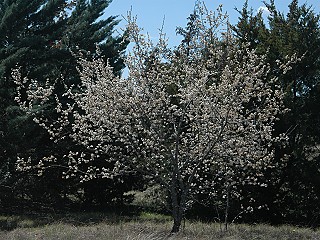 |
| From the trail down the north fenceline, near the dry woods, you can see across the field and the creek to a puff of white in the distance: that's the big Mexican plum that's on our NW corner. The tree isn't very tall: the land slopes down, and then up, that much. We are fortunate to have several good-sized Mexican plums, and some thicketing plums, on the place...and we've planted more. They're good for wildlife, from the bees, butterflies, and other insects that nectar on the flowers in spring, to the animals and birds that eat the tiny plums, and the birds that nest in their branches. And they're beautiful and smell as good as they look. | My mother planted this much younger and smaller Mexican plum at the end of her garden. At its peak, these trees are as spectacular as cherry trees, and they're covered with hungry insects. |
 |
|
| The "Grapevine Epimenis" , Psychomorpha epimenis, looks like a tiny black butterfly from a distance, and flits about so busily that it's hard to get a picture. It's actually a moth (note the feathery antennae.) This one settled on the backyard wild plum right in front of me--a great birthday present. | |
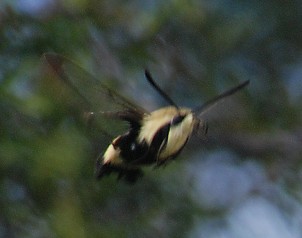 |
|
| Like the Grapevine Epimenis, the Snowberry Clearwing, Hemaris diffinus, is a very active diurnal moth, and on a warm sunny day (as when this was taken) it's hard to catch them at a flower. However...this one, flying away from the plum flowers on which I tried to photograph it, was caught in motion. They look like large, slightly elongated bumblebees, but the square black "tail" makes it fairly easy to spot them. | |
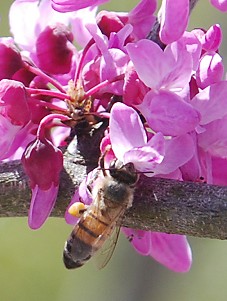 |
 |
| Much as I love the wild plums of early spring and their intoxicating scent, I'm just as fond of the redbuds, and plums and redbuds close to each other are just amazingly beautiful. Redbuds aren't red--they're in shades of deep pink, magenta, and (in a few) purple. Here a bee is nectaring on a thick cluster of redbud flowers. | Anemones, or windflowers, come in three basic colors here: white (the commonest), pink, and a deep blue-violet that ranges from more steely blue to a rich purple. These are the least common, and my favorite. Here is one just opening, a brilliant splash of color against the dead grass behind it. |
 |
|
| We still have wintering sparrows here, including this song sparrow, which feeds amidst a crowd of white-crowned sparrows and the two Harris's sparrows. | |
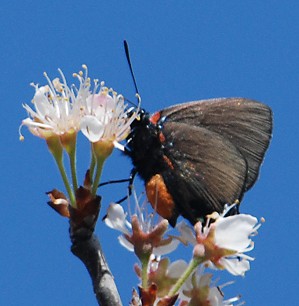 |
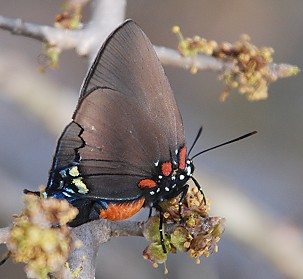 |
| Much larger than the Psychomorpha epimenis, the Great Purple Hairstreak, Atlides halesus, also looks dark from a distance. This one was right at the top of the plum tree, in brilliant sun...so the rear of the abdomen, which is bright orange below, showed up well. | These butterflies also like elbowbush flowers, and the elbowbushes aren't as tall as the Mexican plums, making portraits easier. Here the soft gray-brown underwings are marked with brilliant red spots, above a black and white spotted thorax. The "hairs" on the back of the hindwings aren't visible in this image, but the brilliant blue of the hindwings' upper surface just shows on the undamaged wing...and the two tone abdomen--black with blue markings above, and bright furry orange below--shows up well. |
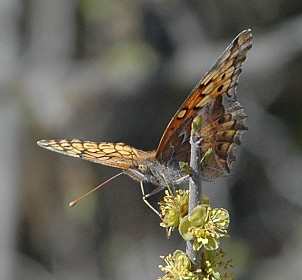 |
|
| Variegated fritillaries, Euptoieta claudia, nectar on both wild plums and elbowbush in early spring. Though I have some decent images of them this spring on a Mexican plum in the near meadow, this shot of one on elbowbush is better as it shows their interesting eyes | |
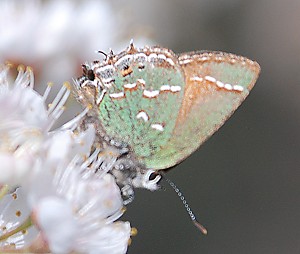 |
 |
| One butterfly commonly found on flowering plums is the Olive Juniper Hairstreak, Callophrys gryneus. We see a lot of these every year, including on juniper trees. | Besides the Mexican plums, we also have thicketing, or suckering, plums, some of which we transplanted to the grass garden from a construction site. They, too, attract butterflies--here, an American Lady, Vanessa virginiensis, showing off the intricate lacework pattern of the hindwings' underside. |
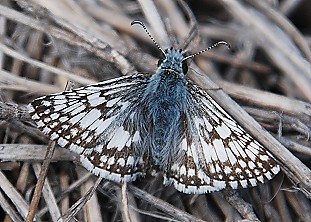 |
|
| Not all butterflies were nectaring on the wild plum blossoms. Saturday Ruta spotted a Common Checkered Skipper, Pyrgus communis, and we followed it as it flew short distances, very low, until we'd gotten good pictures of it. The blue color of the "fur" on the back of the body was obvious at a little distance. | |
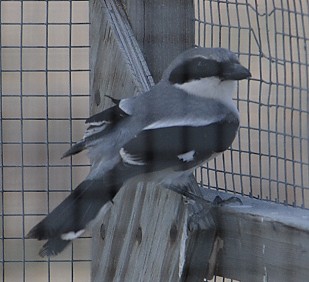 |
|
| Caught in the cowbird trap, a disheveled and very annoyed loggerhead shrike had almost exhausted itself trying to break out, but was able to fly away when Richard caught it (inside the trap) and then released it outside. I'd never been this close (here, about six feet) from a shrike, because these little predators are wary and fly away as soon as I point the camera at them. I shot this through the side of the trap. | |
![]()

